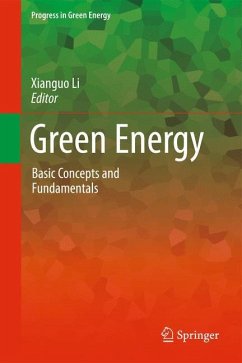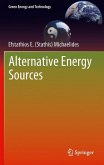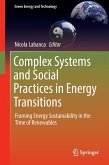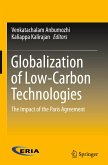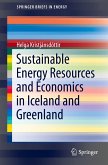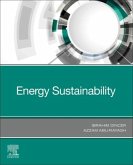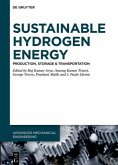Green Energy
Basic Concepts and Fundamentals
Herausgegeben:Li, Xianguo
Green Energy
Basic Concepts and Fundamentals
Herausgegeben:Li, Xianguo
- Broschiertes Buch
- Merkliste
- Auf die Merkliste
- Bewerten Bewerten
- Teilen
- Produkt teilen
- Produkterinnerung
- Produkterinnerung
Green Energy: Basic Concepts and Fundamentals addresses the need for diversity within energy systems. It focuses on the theme of energy diversity with local resources, and the integration and optimisation of conventional and alternative energy systems. The book provides a summary of the state-of-art knowledge and technology for future energy systems, covering topics such as:
- green energy carriers;
- emission control, reduction, and abatement;
- energy conversation and management; and
- energy environment interaction.
This first book in the Progress in Green Energy series will…mehr
Andere Kunden interessierten sich auch für
![Alternative Energy Sources Alternative Energy Sources]() Efstathios E. Michaelides (Stathis)Alternative Energy Sources60,99 €
Efstathios E. Michaelides (Stathis)Alternative Energy Sources60,99 €![Complex Systems and Social Practices in Energy Transitions Complex Systems and Social Practices in Energy Transitions]() Complex Systems and Social Practices in Energy Transitions119,99 €
Complex Systems and Social Practices in Energy Transitions119,99 €![Globalization of Low-Carbon Technologies Globalization of Low-Carbon Technologies]() Globalization of Low-Carbon Technologies150,99 €
Globalization of Low-Carbon Technologies150,99 €![Integrated Resource Strategic Planning and Power Demand-Side Management Integrated Resource Strategic Planning and Power Demand-Side Management]() Zhaoguang HuIntegrated Resource Strategic Planning and Power Demand-Side Management112,99 €
Zhaoguang HuIntegrated Resource Strategic Planning and Power Demand-Side Management112,99 €![Sustainable Energy Resources and Economics in Iceland and Greenland Sustainable Energy Resources and Economics in Iceland and Greenland]() Helga KristjánsdóttirSustainable Energy Resources and Economics in Iceland and Greenland38,99 €
Helga KristjánsdóttirSustainable Energy Resources and Economics in Iceland and Greenland38,99 €![Energy Sustainability Energy Sustainability]() Ibrahim DincerEnergy Sustainability67,99 €
Ibrahim DincerEnergy Sustainability67,99 €![Sustainable Hydrogen Energy Sustainable Hydrogen Energy]() Sustainable Hydrogen Energy120,99 €
Sustainable Hydrogen Energy120,99 €-
-
-
Green Energy: Basic Concepts and Fundamentals addresses the need for diversity within energy systems. It focuses on the theme of energy diversity with local resources, and the integration and optimisation of conventional and alternative energy systems. The book provides a summary of the state-of-art knowledge and technology for future energy systems, covering topics such as:
- green energy carriers;
- emission control, reduction, and abatement;
- energy conversation and management; and
- energy environment interaction.
This first book in the Progress in Green Energy series will be of value to energy researchers, technology developers and professionals from policy makers to engineers, as well as to advanced undergraduate and postgraduates studying in the field.
- green energy carriers;
- emission control, reduction, and abatement;
- energy conversation and management; and
- energy environment interaction.
This first book in the Progress in Green Energy series will be of value to energy researchers, technology developers and professionals from policy makers to engineers, as well as to advanced undergraduate and postgraduates studying in the field.
Produktdetails
- Produktdetails
- Progress in Green Energy 1
- Verlag: Springer / Springer London / Springer, Berlin
- Artikelnr. des Verlages: 978-1-4471-2698-0
- 2011
- Seitenzahl: 304
- Erscheinungstermin: 27. November 2013
- Englisch
- Abmessung: 235mm x 155mm x 17mm
- Gewicht: 464g
- ISBN-13: 9781447126980
- ISBN-10: 144712698X
- Artikelnr.: 39398291
- Herstellerkennzeichnung
- Springer-Verlag GmbH
- Tiergartenstr. 17
- 69121 Heidelberg
- ProductSafety@springernature.com
- Progress in Green Energy 1
- Verlag: Springer / Springer London / Springer, Berlin
- Artikelnr. des Verlages: 978-1-4471-2698-0
- 2011
- Seitenzahl: 304
- Erscheinungstermin: 27. November 2013
- Englisch
- Abmessung: 235mm x 155mm x 17mm
- Gewicht: 464g
- ISBN-13: 9781447126980
- ISBN-10: 144712698X
- Artikelnr.: 39398291
- Herstellerkennzeichnung
- Springer-Verlag GmbH
- Tiergartenstr. 17
- 69121 Heidelberg
- ProductSafety@springernature.com
My academic career began in January 1992 when I joined the University of Victoria as a faculty member after obtaining Masters and Ph.D. degree from Northwestern University, Evanston, Illinois, U.S.A. in 1986 and 1989, respectively and spending the next couple of years at the University of Waterloo, Canada as a postdoctoral fellow and research assistant professor. In 1997 I moved back to the University of Waterloo as a faculty member until now. My research group and I myself are currently focused on promoting/developing green (or greener) energy through energy diversification and energy localization for sustainable development and energy security. Green energy, despite the variety of interpretations possible, is taken as the form and utilization of energy with no, minimal, or reduced negative environmental and societal impact, or simply as environmentally friendly energy use. Therefore, the topical areas of my research activities and interests include, but are not limited to 1. Energy Systems and Energy Policy/Planning: a. Energy and Exergy Analysis and Thermodynamic Optimization b. Energy Systems Evolution, Modelling and Optimization c. Design of Future Energy Systems d. Life Cycle Analysis Sample publication: ¿ Li, X., Diversification and localization of energy systems for sustainable development and energy security. Energy Policy, Vol. 33, pp. 2237-2243, 2005. ¿ Dincer, I., S. Dost and X. Li, Energy reality and future projections for Canada. Energy Sources - Journal of Extraction, Conversion, and the Environment, Vol. 19, No. 3, pp. 233-243, 1997. ¿ Hussain, M.M., J. Baschuk, X. Li and I. Dincer, Thermodynamic analysis of a PEM fuel cell power system. International Journal of Thermal Sciences, Vol. 44, pp. 903-911, 2005. ¿ Zamel, N. and X. Li, Life cycle analysis of vehicles powered by a fuel cell andinternal combustion engine for Canada. Journal of Power Sources, accepted, March 2005. 2. Renewable Energy: a. Wind Energy: Wind energy potential assessment, and theoretical determination of the probability distribution of wind speed Sample publication: ¿ Li, M. and X. Li, Investigation of wind characteristics and assessment of wind energy potential for Waterloo Region, Canada. Energy Conversion and Management, Vol. 46, pp. 3014-3033, 2005. ¿ Li, M. and X. Li, MEP-type distribution function: a better alternative to Weibull function for wind speed distribution. Renewable Energy, Vol. 30, pp. 1221-1240, 2005. ¿ Li, M. and X. Li, On the probabilistic distribution of wind speeds: theoretical development and comparison with data. International Journal of Exergy, Vol. 1, No. 2, pp. 237-255, 2004. 3. Energy Conversion Technologies: a. Fuel Cells: I. PEM Fuel Cells: modeling, experiment, design of flow fields and bipolar plates, scaling law for cell and stack design, CO poisoning and mitigation, transport through membrane II. Direct Methanol Fuel Cells: modeling of transport phenomena and cell performance III. SOFCs: energy and exergy analysis, transport phenomena modeling and cell performance Sample publication: ¿ Karimi, G., J.J. Baschuk and X. Li, Performance Analysis and Optimization of PEM Fuel Cell Stacks Using Flow Network Approach. Journal of Power Sources, Vol. 147, pp. 162-177, 2005. ¿ Karimi, G. and X. Li, Electroosmotic flow through polymer electrolyte membranes in PEM fuel cells. Journal of Power Sources, Vol. 140, pp. 1-11, 2005. ¿ Sabir, I. and X. Li, Review of bipolar plates in PEM fuel cells: flow field designs. International Journal of Hydrogen Energy, Vol. 30, pp. 359-371, 2005 ¿ Hum, B. and X. Li, Two-dimensional analysis ofPEM fuel cells. Journal of Applied Electrochemistry, Vol. 34, No. 2, pp. 205-215, 2004. ¿ Baschuk, J.J. and X. Li, Mathematical model of a PEM fuel cell incorporating CO poisoning and O2 (Air) Bleeding. International Journal of Global Energy Issues, Vol. 20, No. 3, pp. 245-276, 2003. ¿ Baschuk, J.J. and X. Li, Modeling CO poisoning and O2 bleeding in a PEM fuel cell anode. International Journal of Energy Research, Vol. 27, pp. 1095-1116, 2003. ¿ Li, X., Fuel cells - the environmentally friendly energy converter and power generator. International Journal of Global Energy Issues, Vol. 17, Nos. 1/2, pp. 68-91, 2002. ¿ Rowe, A. and X. Li, Mathematical modelling of proton exchange membrane fuel cells. Journal of Power Sources, Vol. 102, pp. 82-96, 2001. ¿ Baschuk, J.J. and X. Li, Modelling of polymer electrolyte membrane fuel cells with variable degrees of water flooding. Journal of Power Sources, Vol. 86, No. 1-2, pp.181-196, 2000. ¿ Marr, C.L. and X. Li, Composition and performance modelling of catalyst layer in a proton exchange membrane fuel cell. Journal of Power Sources, Vol. 77, pp. 17-27, 1999. b. Low Emission Combustion Technology: Liquid fuel atomization and spray combustion I. Liquid Fuel Atomization and Spray Formation II. Probability Distribution of Spray Droplet Sizes and Velocities III. Experimental Characterization of Spray Formation Processes and Spray Droplet Sizes and Velocities IV. Spray and Ambient Air Stream Interaction V. Droplet Vaporization and Ignition Sample publication: ¿ Park, J., K.Y. Huh, X. Li and M. Renksizbulut, Experimental investigation on cellular breakup of a planar liquid sheet from an air-blast nozzle. Physics of Fluids, Vol. 16, No. 3, pp. 625-632, March 2004. ¿ Li, X. and M. Li*, Droplet size distribution insprays based on maximization of entropy generation. Entropy, Vol. 5, pp. 417-431, 2003. ¿ Kim, W. T.**, S. K. Mitra*, X. Li, L.A. Prociw and T.C.J. Hu, A predictive model for the initial droplet size and velocity distributions in sprays and comparison with experiments. Particle & Particle Systems Characterization, Vol. 20, No. 2, pp. 135-149, 2003. ¿ Chen, X.-Q.**, M. Renksizbulut and X. Li, Interaction of a particle-laden gaseous jet with a confined annular turbulent flow. Particle & Particle Systems Characterization, Vol. 18, No. 3, pp. 120-133, 2001. ¿ Li, X. and J. Shen*, Experiments on annular liquid jet breakup. Atomization and Sprays, Vol. 11, No. 5, pp. 557-573, 2001. ¿ Shen, J.* and X. Li, Absolute and convective instability of annular viscous liquid jets in gas streams. Atomization and Sprays, Vol. 11, No. 5, pp. 491-504, 2001. ¿ Mitra, S.K.*, X. Li and M. Renksizbulut, On the breakup of viscous liquid sheets by dual mode linear analysis. AIAA Journal of Propulsion and Power, Vol. 17, No. 3, pp. 728-735, 2001. ¿ Chen, X.Q.**, J.A. Friedman, X. Li and M. Renksizbulut, An improved method to determine particle dispersion width for efficient modeling of turbulent two-phase flows. Particle & Particle Systems Characterization, Vol. 17, No. 4, pp. 180-188, 2000. ¿ Cao, J.** and X. Li, Stability of plane liquid sheets in compressible gas streams. AIAA Journal of Propulsion and Power, Vol. 16, No. 4, pp. 623-627, 2000. ¿ Jazayeri, S.A.* and X. Li, Nonlinear instability of plane liquid sheets. Journal of Fluid Mechanics, Vol. 406, pp. 281-308, 2000. ¿ Li, X. and M. Renksizbulut, Further development and application of a tomographical data processing method for laser diffraction measurements in sprays. Particle and Particle Systems Characterization, Vol.16, pp. 212-219, 1999. ¿ Chen, X.-Q.**, M. Renksizbulut and X. Li, A stochastic-probabilistic model for simulating particle dispersion in general coordinates. Numerical Heat Transfer, Part B: Fundamentals, Vol. 36, No. 1, pp. 57-82, 1999. ¿ Li, X., Droplet autoignition in a reactive oxidant/fuel-vapor/inert environment. AIAA Journal of Propulsion and Power, Vol. 13, No. 1, pp. 89-96, 1997. ¿ Shen, J.* and X. Li, Instability of an annular viscous liquid jet. Acta Mechanica, Vol. 114, pp. 167- 183, 1996. ¿ Li, X., Mechanism of atomization of a liquid jet. Atomization and Sprays, Vol. 5, pp. 89-105, 1995. ¿ Li, X., Spatial instability of plane liquid sheets. Chemical Engineering Science, Vol. 48, pp. 2973- 2981, 1993. ¿ Li, X. and R.S. Tankin, On the prediction of droplet size and velocity distributions in sprays through maximum entropy principle. Particle and Particle Systems Characterization, Vol. 9, pp. 195-201, 1992. ¿ Renksizbulut, M., M. Bussmann and X. Li, A droplet vaporization model for spray calculations. Particle and Particle Systems Characterization, Vol. 9, pp. 59-65, 1992. ¿ Li, X. and M. Renksizbulut, Droplet ignition with variable properties and distinct binary diffusion coefficients. AIAA Journal, Vol. 29, pp. 1131-1135, 1991. ¿ Li, X. and R.S. Tankin, On the temporal instability of a two-dimensional viscous liquid sheet. Journal of Fluid Mechanics, Vol. 226, pp. 425-443, 1991. ¿ Renksizbulut, M., R. Nafziger and X. Li, A mass transfer correlation for droplet evaporation in high-temperature flows. Chemical Engineering Science, Vol. 46, pp. 2351-2358, 1991. ¿ Li, X. and R.S. Tankin, Spray behavior in nonswirling and swirling annular air flows. Atomization and Sprays, Vol. 1, pp. 319-336, 1991. ¿ Li, X. and R.S. Tankin, Spraybehavior in annular air streams. Combustion Science and Technology, Vol. 64, pp. 141-165, 1989. 4. Energy Conservation and Management: a. Energy Storage Techniques: Thermal energy storage b. Green Houses/Buildings: Double glass window insulation and heat transfer loss subject to transient wall temperature variations c. Energy Efficiency Improvement for Industrial Processes: Cooling of electric transformers, cooling of structural steel products in steel mills (rolling and in cooling beds) Sample publication: ¿ Zhang, J. and X. Li, Oil cooling for disk-type transformer windings - Part 1: Theory and model development. Accepted for publication in IEEE Transactions on Power Delivery, June 2004. ¿ Zhang, J. and X. Li, Oil cooling for disk-type transformer windings - Part 2: Parametric Studies of design parameters. Accepted for publication in IEEE Transactions on Power Delivery, June 2004. ¿ Zhang, J. and X. Li, Natural cooling oil flow in disk-type transformer windings with zigzag flow passages. International Journal of Transport Phenomena, Vol. 7, pp. 199-218, 2005. ¿ Zhang, J. and Li, X., Coolant flow distribution and pressure loss in ONAN transformer windings - Part 1: theory and model development. IEEE Transactions on Power Delivery, Vol. 19, No. 1, pp. 186-193, 2004. ¿ Zhang, J. and Li, X., Coolant flow distribution and pressure loss in ONAN transformer windings - Part 2: Optimization of Design Parameters. IEEE Transactions on Power Delivery, Vol. 19, No. 1, pp. 194-199, 2004. ¿ Dincer, I., S. Dost and X. Li, Performance analyses of sensible heat storage systems for thermal applications. International Journal of Energy Research, Vol. 21, No. 10, pp. 1157-1171, 1997. ¿ Dincer, I., S. Dost and X. Li, Thermal energy storage applications from an energysaving perspective. International Journal of Global Energy Issues, Vol. 9, Nos 4-6, pp. 351-364, 1997. ¿ Li, X., Natural convection in vertical slots with wall temperature oscillation. Experiments in Fluids, Vol. 16, pp. 308-315, 1994.
1. Green Energy for Sustainability and Energy Security.- 2. Exergy Analysis of Green Energy Systems.- 3. Wind Speed Distribution - A Theoretical Approach to Probability Density Function.- 4. Co-combustion and Gasification of Coal and Cattle Biomass: A Review of Research and Experimentation.- 5. Polymer Electrolyte Fuel Cell Modeling - A Pore-Scale Perspective.- 6. Nanostructured Hydrides for Solid State Hydrogen Storage for Vehicular Applications.
1. Green Energy for Sustainability and Energy Security.- 2. Exergy Analysis of Green Energy Systems.- 3. Wind Speed Distribution - A Theoretical Approach to Probability Density Function.- 4. Co-combustion and Gasification of Coal and Cattle Biomass: A Review of Research and Experimentation.- 5. Polymer Electrolyte Fuel Cell Modeling - A Pore-Scale Perspective.- 6. Nanostructured Hydrides for Solid State Hydrogen Storage for Vehicular Applications.

